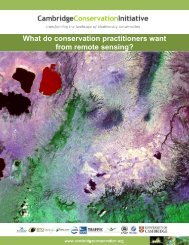CONSERVING BIODIVERSITY & DELIVERING ECOSYSTEM SERVICES
conserving biodiversity & delivering ecosystem services
conserving biodiversity & delivering ecosystem services
You also want an ePaper? Increase the reach of your titles
YUMPU automatically turns print PDFs into web optimized ePapers that Google loves.
Although grasslands are important habitats for biodiversity and ecosystem<br />
services, Nepal has no national policies for the sustainable use and<br />
management of grasslands. Indeed, policy-makers are often unaware of their<br />
importance. In the grassland protected areas of the Terai (e.g. Chitwan<br />
National Park and Koshi Tappu Wildlife Reserve), management attempts to<br />
strike a balance between the needs of local people and the conservation of<br />
biodiversity by allowing people to harvest grasses for a limited period of time<br />
each year.<br />
<br />
This study shows: Across the network of IBAs, the area of grasslands is<br />
(Jyotendra Jyu Thakuri)<br />
anticipated to decline if current pressures and trends continue. Some<br />
ecosystem services delivered by grasslands would decline as a result, notably the provision of wild harvested goods such as<br />
fodder for livestock which are vital for local communities.<br />
Key recommendations<br />
■ Raise awareness of policy- and decision-makers of the importance of grasslands for biodiversity and ecosystem services,<br />
and the benefits to poor communities<br />
■ Engage in / stimulate dialogue on the formulation of national policies for grasslands, covering both protected and nonprotected<br />
areas, in the mountains and Terai, that take account of conservation of biodiversity and delivery of ecosystem<br />
services to poor people<br />
■ At grassland sites, support local communities in the sustainable management of grasslands for the benefit of both<br />
people and biodiversity, providing technical support and building their skills<br />
<br />
There has been a long history of establishing national policies and legislation<br />
for wetlands in Nepal indicating the early recognition of their importance. An<br />
early example is the Water Resources Act 1992 which sets out guidelines for<br />
the sustainable use of water and promotes environmental impact<br />
assessments. Perhaps of most significance is the commitment that Nepal has<br />
shown to the conservation of wetlands, especially waterfowl habitats of<br />
international importance, by signing the Ramsar Convention on Wetlands of<br />
International Importance. Under this convention, each signatory agrees to<br />
promote the sustainable use of all wetlands in their territory, and to designate<br />
suitable wetlands for inclusion in a List of Wetlands of International<br />
(Andy Graham)<br />
Importance (so-called ‘Ramsar sites’) according to fixed criteria, and to promote the conservation of these sites, including<br />
through monitoring and notification of changes to threats to sites. There are currently nine wetlands in Nepal which have<br />
been designated as Ramsar sites of which all are IBAs, namely Koshi Tappu Wildlife Reserve, Ghoda Ghodi Lake, Jagdishpur<br />
reservoir, Gokyo Lake (Sagamartha National Park), Rara Lake (Rara National Park), Phoksundo Lake (Shey-Phoksundo National<br />
Park), Gosainkunda Lake (Langtang National Park), Mai Pokhari (Mai Valley Forests) and Bees Hazari Lake ( Barandabhar Forests<br />
and Wetlands).<br />
The primary goal of the National Wetland Policy 2003, reflecting Nepal’s obligations under the Ramsar convention, is to<br />
conserve and manage wetland resources wisely and in a sustainable way with the participation of local people. Following on<br />
from this, the Government has initiated a number of projects to mainstream wetland resources in national policies and<br />
programmes, for example the Conservation and Sustainable Use of Wetlands in Nepal (CSUWN) project, which has been<br />
instrumental in establishing institutional and policy support, along with grassroots sustainable livelihoods activities, and which<br />
has prepared a Conservation, Education, Participation and Awareness (CEPA) Strategy and Dissemination Framework (2011–2015)<br />
for the Department of National Parks and Wildlife Conservation (DNPWC), the Ramsar Authority of Nepal.<br />
This study shows: Wetlands in IBAs are not anticipated to change significantly in terms of land cover but many of the<br />
services provided by them are expected to decline if current pressures and trends continue. There are, however, opportunities<br />
for recreation and tourism to increase, for example at the Ramsar sites, where nature-based recreation is becoming<br />
increasingly popular.<br />
Key recommendations<br />
■ Raise awareness through the CEPA Strategy and Dissemination Framework (2011–2015, DNPWC) of policy- and<br />
decision-makers of the value of wetlands for biodiversity and ecosystem services, and the benefits to poor communities<br />
■ At wetland sites, support wetland-dependent indigenous communities in the sustainable management of wetland<br />
resources for the benefit of both people and biodiversity, providing technical support (e.g. CSUWN’s Wetlands<br />
Economic Evaluation Tool, and Wetlands Inventory, Assessment and Monitoring framework) and building on their skills<br />
■ At wetland sites, promote sustainable wetland-based tourism and recreation with a focus on wildlife/birdwatching<br />
activities, ensuring that benefits are captured locally




